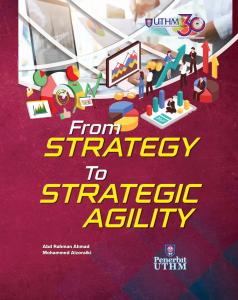From Strategy to Strategic Agility
Keywords:
Strategy, emergence, capability, efficiencySynopsis
In the contemporary business world, the robustness of an organization is crucial as the business environment is very complex and uncertain. The growth and development of an organization heavily depend on internal and external factors. Therefore, it is imperative to find an effective and optimal way to confront this change with the emergence of strategic agility. Agility is considered indispensable for all organizations operating in a rapidly growing or turbulent environment. Here, the application of strategic agility in organizations requires the availability of leaders with high efficiency and skills, as well as knowledge and capability to organize the organizational structure that allows for collaboration between the various levels of the organization. These will facilitate a supportive, careative and innovative organizational climate. Thus, the swift response ensures the organization to remain competitive or sustains its business operations effectiveness. Therefore, the organization must have strategic sensitivity, collective commitment and ensure the flow of resources is able to be fully employed.
Downloads
References
A. Steiber and S. Alänge (2013). A corporate system for continuous innovation: the case of google inc. European Journal of Innovation Management, 16(2):243–264,
Abu-Radi, S., & Al-Hawajreh, K. M. (2013). Strategic agility and its impact on the operations competitive capabilities in Jordanian private hospitals. Jordan: Middle East University.
Aghina W., De Smet, A., Lackey G., Lurie M. Murarka M. 2018. The five trademarks of agile companies. McKinsey Report 2018
Ahlbäck K, Fahrbach C, Murarka M, S. O. (2017). How to create an agile organization. McKinsey & Company Organization. https://www.mckinsey.com/busin ess-funct ions/organ izati on/our-insig hts/ how-to-create-an-agile -organ izati on. Accessed 2 Sept 2019.
Akkaya, B. (2020). Review of leadership styles in perspective of dynamic capabilities: An empirical research on managers in manufacturing firms. Yönetim Bilimleri Dergisi, 18(36), 389–407.
Akkaya, B., & Tabak, A. (2017). The impact of dynamic capabilities on firm perceived marketing performance of small and medium-sized enterprises. Transnational Marketing Journal, 5(2), 121–125.
Alahyari, H., Svensson, R. B., & Gorschek, T. (2017). A study of value in agile software development organizations. Journal of Systems and Software, 125, pp. 271-288.
Alberts, D. S., Hayes, R. E. (2003), Power to the Edge: Command and Control in the Information Age, Command & Control Research Program, Washington.
Aleisa, Y. (2017). Factors Affecting Implementation of Enterprise Risk Management (ERM): An Exploratory Study Among Saudi Organizations (Doctoral dissertation, University of Liverpool).
Alhadid, A. Y. (2015). Effective Determinations on Organization Agility Practices: Analytical Study on Information Technology organization in Jordan. 34–39.




